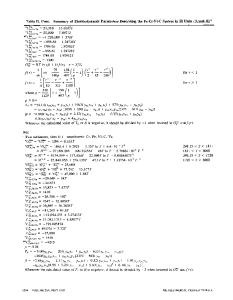Thermodynamic assessment of liquid Fe-Mn-C system
- PDF / 301,958 Bytes
- 7 Pages / 612 x 792 pts (letter) Page_size
- 40 Downloads / 285 Views
I.
INTRODUCTION
THE thermodynamic information of the Fe-Mn-C system is required for developing and improving the process of high-manganese-containing steels and ferromanganese alloys. Unlike the systems which are relevant to the processes for regular-grade steels, the experimental investigation of the Fe-Mn-C system pertinent to the process of high-alloy steels and ferromanganese alloys is limited in scope and number. The need often has been met by assessing the available information with the use of the solution models. The success for such assessments depends on the data and the choice of the model. Recent notable activities of the assessment of the Fe-Mn-C system are by Dresler[1] and Li and Morris.[2] Both employed the Wagnerian Taylor series formalism in the mole fraction coordinate. Although their assessed results adequately describe the solution properties of the Fe-Mn-C system, the representation can be improved further. Chipman[3] proposed the lattice site ratio model to describe the solution properties for the systems with interstitial solutes. Chipman and Brush[4] applied the lattice site ratio model to represent the solution properties of C in austenite. The liquid system does not retain a rigid crystal structure, as observed in the solid system, but exhibits a short-range order. The short-range order is the consequence of a close packing arrangement of atoms with a similar structure to that of the solid system. Therefore, the concept of the lattice site ratio model is applicable for describing the solution properties of the liquid system. Ban-ya and Chipman[5] and Chipman[6] successfully described the thermodynamic properties of sulfur in the liquid solvent systems. The present study discusses the application of the lattice site ratio model to the liquid Fe-Mn-C system and shows that the mathematical treatment to represent the soYOUNG E. LEE, Senior Specialist, is with the Elkem Metals Company, Marietta, OH 45750-0299. Manuscript submitted April 17, 1997. METALLURGICAL AND MATERIALS TRANSACTIONS B
lution properties becomes simple, as the properties of the ternary system can be expressed as linear combinations of those of the constituent binary systems when they are defined in the lattice site ratio coordinate. The assessed results in the lattice site ratio coordinate are organized in the mole fraction coordinate as a practical alternative expression. II.
LATTICE SITE RATIO MODEL
Chipman[3] and Chipman et al.[4] showed that the solution properties of the interstitial solute in solvent are described better when the ratio of filled to unfilled interstitial sites is used as a concentration parameter instead of the mole fraction, and they suggested the following concentration parameter for the system containing various interstitial and substitutional elements: z2 5
n2 n1 1 Σvj nj
[1]
where n1 and n2 are the number of solvent and interstitial solute atoms, nj denotes the additional constituent atoms, and vj is 11 for substitutional and 21/b for interstitial solutes. The term b is the number of the int
Data Loading...











